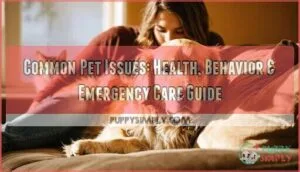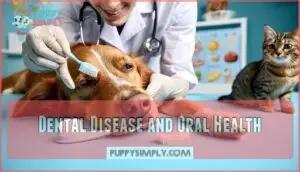This site is supported by our readers. We may earn a commission, at no cost to you, if you purchase through links.
 Your dog limps after playing fetch, your cat stops eating breakfast, or you notice unusual scratching that won’t quit—most pet owners face these moments of quiet alarm more often than they’d like.
Your dog limps after playing fetch, your cat stops eating breakfast, or you notice unusual scratching that won’t quit—most pet owners face these moments of quiet alarm more often than they’d like.
By age three, four out of five dogs already battle dental disease, while skin allergies top insurance claims year after year.
These common pet issues rarely announce themselves with dramatic symptoms; instead, they creep in through small changes you might dismiss until they’ve stolen months or years from your companion’s life. Recognizing early warning signs and understanding when routine care shifts to urgent intervention can transform your ability to protect the animals who depend on you.
Table Of Contents
- Key Takeaways
- What Are The Most Common Pet Health Issues?
- How Can I Prevent Pet Health Problems?
- What Should I Know About Pet Behavioral Issues?
- When is Emergency Vet Care Needed?
- How Can I Care for My Pet at Home?
- Frequently Asked Questions (FAQs)
- What are some common triggers for pet allergies and how can I eliminate them?
- How can I prevent joint injuries and lameness in my pet?
- What vaccinations does my pet need annually?
- How often should I groom my pet?
- Can I give human medications to pets?
- What foods are toxic to dogs and cats?
- How do I choose the right veterinarian?
- Conclusion
Key Takeaways
- Dental disease affects 80% of dogs and 70% of cats by age three, making daily brushing and regular vet cleanings essential to prevent infections that can damage the heart and kidneys.
- Skin allergies represent the top pet insurance claim for 13 consecutive years, with treatment costs averaging $266 initially but reaching $841 in the first year if not addressed early through proper diagnosis and allergen testing.
- Over half of U.S. pets are overweight or obese, a condition that directly triggers diabetes, joint deterioration, and heart disease while stealing years from your pet’s life.
- Regular veterinary checkups detect problems in 20% of adult dogs and 33% of cats annually before symptoms appear, making prevention consistently more effective and affordable than treating advanced conditions.
What Are The Most Common Pet Health Issues?
Your pet’s health depends on catching problems early, and some issues show up more often than others. From dental disease to skin allergies, these conditions affect millions of pets each year.
Let’s look at the most common ones.
Dental Disease and Oral Health
Dental disease is the most diagnosed health issue in companion animals, affecting up to 80% of dogs and 70% of cats by age three. Without proper dental hygiene, plaque hardens into tartar, triggering gum disease and periodontal infections that can damage your pet’s heart and kidneys.
Daily brushing with a pet toothbrush and veterinary dental cleanings prevent periodontitis and oral infections, protecting your pet’s overall health. Regular dental health checks are essential for maintaining a pet’s oral hygiene and preventing severe dental problems.
Skin Conditions and Allergies
Skin allergies rank as the top pet insurance claim for 13 consecutive years, affecting roughly 25% of dogs during their lifetime. Your pet’s itching, redness, or hair loss might stem from environmental triggers, food sensitivities, or parasites—conditions collectively known as pet dermatitis.
Getting the right diagnosis matters because skin issues can point to different underlying problems:
- Pyoderma affects 60.8% of dermatology cases, often requiring targeted antibiotic therapy
- Atopic dermatitis impacts 3-15% of dogs, with allergen-specific immunotherapy improving symptoms in 59% of patients
- Treatment costs average $266 initially but can reach $841 within the first year
Early allergy testing and itch management prevent your pet’s discomfort from escalating into chronic canine eczema or secondary infections. Professional evaluation identifies whether allergic reactions require diet trials, immunotherapy, or skin microscopy for precise treatment planning. Effective allergen therapy can markedly improve a dog’s quality of life.
Obesity and Weight Management
Over half of U.S. pets are overweight or obese—a silent epidemic that steals years from your companion’s life. Excess weight isn’t just cosmetic; it triggers diabetes, joint deterioration, and heart disease.
Neutered pets and older animals face higher risk, making veterinary care and weight management essential. Prescription diets achieve better results than standard food, but success hinges on your commitment to proper pet nutrition and obesity prevention through controlled healthy feeding and consistent exercise.
Gastrointestinal and Digestive Problems
Think of your pet’s digestive system as an early warning system—it’s often the first place problems show up when something’s off elsewhere in their body.
GI issues can be anything from a minor stomach bug to something more serious like inflammatory bowel disease.
Here are signs that mean it’s time to call your vet:
- Persistent vomiting or diarrhea lasting beyond 24 hours
- Blood in stool or sudden appetite loss
- Lethargy combined with stomach issues
Food allergies compromise gut health, while digestive enzymes support proper pet nutrition and overall pet health and wellness.
Urinary Tract and Ear Infections
Bacterial and fungal invaders don’t discriminate—both urinary tracts and ear canals provide warm, moist environments where infections thrive if left unchecked. You’ll notice straining during urination, frequent squatting, or head shaking and scratching.
Urinary tract infections and bladder issues require prompt diagnosis, while ear infections and ear mites need targeted treatment. Kidney stones can develop silently, making regular screening essential for catching bladder or urinary tract disease early.
Don’t wait—these pet health issues worsen quickly without intervention.
How Can I Prevent Pet Health Problems?
When it comes to your pet’s health, catching problems early beats dealing with them later.
Here’s the upside: most common health issues don’t have to happen at all if you stay on top of a few essential basics.
Here are the practical steps to keep your pet healthy and spot potential problems before they escalate.
Importance of Regular Veterinary Check-ups
Think of routine vet visits as your pet’s annual tune-up—catching small problems before they snowball into expensive emergencies that could have been prevented with a simple exam. Regular checkups allow veterinarians to perform health screenings that detect issues you can’t see at home. These preventive measures form the cornerstone of pet wellness:
- Early detection of dental disease before pain develops
- Monitoring weight trends to prevent obesity
- Screening for internal parasites and organ function
- Updating preventive care protocols as your pet ages
Vaccination Schedules and Preventive Care
Vaccines work like training drills for your pet’s immune system—preparing them to fight diseases before exposure happens. Core vaccinations protect against life-threatening illnesses like rabies, distemper, and parvovirus, while booster shots maintain that protection throughout your pet’s life. Pet insurance often covers preventive care, making routine vaccinations more affordable.
Starting early matters: puppies and kittens need initial doses every 2–4 weeks until they’re 16 weeks old, then regular boosters based on your vet’s recommendations. These preventive measures dramatically reduce disease risk—vaccination campaigns reaching 70% coverage have eliminated rabies in entire regions.
| Vaccine Type | First Dose Timing | Booster Schedule |
|---|---|---|
| Core Vaccinations (Dogs) | 6–8 weeks | Every 1–3 years |
| Core Vaccinations (Cats) | 6–8 weeks | Every 1–3 years |
| Rabies | 14–16 weeks | Every 1–3 years |
| Lifestyle Vaccines | Based on risk | Annually or as needed |
| Initial Course Completion | By 16 weeks | N/A |
Preventive care visits detect problems in 20% of adult dogs and 33% of cats annually—catching issues before symptoms appear saves both heartache and money.
Proper Nutrition and Diet Choices
What you feed your pet isn’t just fuel—it’s the foundation of their immune system, energy levels, and long-term health. Proper nutrient balance prevents common pet health issues while supporting everything from dental health to weight management. Here’s what matters most in dog nutrition and pet care:
- Choose age-appropriate formulas that match your pet’s life stage and activity level
- Monitor for food allergies through gradual diet transitions and symptom tracking
- Plan consistent meal times to regulate digestion and prevent overeating
- Use pet supplements only when your vet identifies specific deficiencies
- Offer healthy snacks sparingly—treats shouldn’t exceed 10% of daily calories
Investing in quality ingredients now saves you vet bills and heartache down the road.
Exercise and Weight Management
Your pet’s weight affects every breath they take, every step they climb, and every year you’ll have together—yet nearly 60% of dogs and cats in the US carry excess pounds that silently threaten their quality of life.
Obesity increases the risk of diabetes, heart disease, and joint problems—conditions you can prevent with consistent physical activity and portion control.
Work with your veterinarian to develop exercise plans customized to your pet’s age and abilities, then build healthy habits through daily walks, play sessions, and monitored calorie intake that aids gradual weight loss without compromising nutrition.
Preventing Dental and Skin Issues
Dental disease affects 80-90% of dogs over age three, yet most pet owners don’t discover the damage until their companion is already suffering from painful infections or tooth loss. Prevention starts at home with consistent attention to oral health and skin care.
- Brush your pet’s teeth daily using pet-specific toothpaste to prevent periodontal disease and dental hygiene complications.
- Schedule annual dental cleanings with your veterinarian to address tartar buildup before it progresses.
- Monitor your pet’s coat during pet grooming sessions for signs of skin allergies, skin problems, or parasites.
- Address skin issues early—environmental allergies and dietary sensitivities often manifest as itching, redness, or a dull, unhealthy coat that compromises your pet’s comfort and well-being.
What Should I Know About Pet Behavioral Issues?
Behavioral problems show up in almost every dog and plenty of cats too, but most pet owners wait until things get bad before doing anything about them. The frustration is real, but that’s not the whole story—these behaviors often point to anxiety, fear, or health problems that are making your pet miserable.
Here are the behavioral issues you’re most likely to encounter—and the signs that it’s time to bring in expert help.
Separation Anxiety and Attachment Concerns
Hyperattachment often creates a burden for both you and your pet. Dogs with Separation Anxiety exhibit urination, destructive chewing, or persistent barking when left alone—signs of Canine Stress rooted in insecure Pet Attachment. About 52% of owners report these Animal Separation behaviors.
Establishing Owner Boundaries through gradual departures helps. Veterinary Services and Support, including behavioral modification and sometimes medication, address underlying Animal Health and Wellness concerns. Pet Health Insurance may cover treatment costs for severe cases requiring ongoing Pet Care and Maintenance interventions.
Aggression and Fear in Pets
Aggression in dogs, whether directed at people or other animals, affects more than half of dogs in the U.S. and often stems from the same fear that drives attachment issues. Fear-Based Aggression manifests when your pet perceives a threat—whether real or imagined. You’ll notice warning signs like growling, lip curling, or sudden lunging.
Feline Aggression follows similar patterns but may include hissing and swatting.
Early Socialization Techniques help reduce Canine Fearfulness, though some Pet Anxiety ties to health problems like Allergies or Allergic Reactions causing discomfort. Your veterinarian can distinguish behavioral from medical triggers and recommend appropriate treatment.
Signs of Stress and Anxiety
Beyond the obvious growls and lunges, stress in pets shows up in subtler ways—repeated paw licking, excessive shedding, changes in appetite, or withdrawal from activities they once enjoyed.
These stress signals often mimic allergic reactions or skin allergies, so your veterinarian can help identify anxiety triggers versus actual pet health problems.
Calming techniques and emotional support improve animal wellness when panic attacks arise.
When to Seek Professional Help
If those warning signs persist for more than a few days or start interfering with your pet’s daily life, it’s time to call your veterinarian rather than waiting for the problem to resolve on its own. Behavior specialists can assess whether medical emergencies like pet poisoning or illness are causing the changes.
Emergency care may be needed if your pet shows signs of distress, and vet consultations help rule out urgent care situations requiring immediate first aid or treatment.
When is Emergency Vet Care Needed?
Knowing when your pet needs emergency care can mean the difference between a full recovery and a tragic outcome. Some situations require immediate veterinary attention, while others can wait until morning.
Let’s break down which situations need a vet right now—and what you should do when they happen.
Recognizing Signs of a Pet Emergency
Knowing when your pet needs emergency care can mean the difference between life and death. Respiratory Distress—labored breathing, blue gums, or gasping—appears in over 85% of critical cases and demands immediate action.
Severe Bleeding that won’t stop with pressure, Sudden Collapse, repeated vomiting, seizures, or Toxic Ingestion all signal pet emergencies requiring urgent Emergency Response.
Don’t wait if symptoms escalate; emergency care and first aid knowledge empower you to protect your companion when seconds count.
Common Emergencies and Immediate Actions
When a true emergency strikes—from bloat to toxin exposure—your swift, informed response becomes your pet’s lifeline. Keep your First Aid Kits stocked and ready, call Poison Control for suspected Toxin Ingestion, and transport carefully to minimize Trauma during Critical Care situations.
Common emergencies demanding Urgent Interventions:
- Distended Abdomen with pale gums or weakness (bloat requires immediate surgery)
- Heat Stroke with panting, drooling, collapse
- Severe Vomiting or diarrhea causing dehydration
- Seizures lasting over three minutes
- Visible Trauma from accidents or falls
Your Emergency Response preparation directly impacts survival outcomes.
Contacting Emergency Veterinary Services
Having the right emergency contact information saved before a crisis hits can shave precious minutes off your response time—minutes that often mean the difference between recovery and tragedy. Program your primary vet, nearest 24-hour Emergency Care facility, and Pet Insurance provider into your phone now.
For immediate guidance on pet health issues, call Emergency Vet Services at 630-584-7447—their medical staff provides real-time Crisis Management support. Keep Vet Hotlines and Poison Control numbers (888-426-4435) posted on your refrigerator for Urgent Care situations when every second counts.
First Aid Tips for Pet Owners
Your pet’s first aid kit should live in the same accessible spot you’d keep your own—stocked, clearly labeled, and ready to deploy the moment something goes wrong.
Include gauze and bandages for pet wound care, hydrogen peroxide for emergency response (only if Poison Control advises it), a muzzle, and a digital thermometer.
Learn pet CPR basics before you need them—knowing how to treat pet ailments during common pet emergencies can stabilize symptoms until professional help arrives.
How Can I Care for My Pet at Home?
Caring for your pet at home starts with simple, consistent habits that support their overall wellbeing. From dental care to monitoring subtle changes in behavior, you play a key role in catching problems early and keeping them comfortable between vet visits.
Focus on these basics to keep your pet healthy day-to-day.
At-Home Dental and Skin Care
Taking care of your pet’s dental and skin health at home does more than save you a trip to the vet—it catches problems while they’re still small.
Regular tooth brushing with pet-safe toothpaste fights off periodontal disease, and grooming sessions give you a chance to notice skin conditions, allergies, or irritation before they get worse.
These simple practices support oral health and address skin problems before they escalate, reducing the need for intensive veterinary care down the road.
Safe Remedies and When to Avoid Them
Some natural supplements and home remedies—like bland diets for mild diarrhea or canned pumpkin for constipation—can be helpful first aid for pets when used appropriately.
However, human medications cause 17% of pet poisoning cases annually, and herbal treatments carry real risks without veterinary guidance.
Before treating pet ailments at home, consult your veterinarian to avoid pet toxicity and guarantee you’re addressing pet health problems safely, not masking something more serious.
Monitoring Your Pet’s Health
Keeping a close eye on your pet between vet visits helps you catch small changes before they become big problems. Track eating habits, energy levels, bathroom routines, and any shifts in behavior—these patterns reveal early warning signs of pet health issues.
Use health monitoring tools like weight logs or wellness apps if helpful, and discuss concerns with your veterinarian promptly to support your pet’s long-term animal health.
Partnering With Veterinarians for Ongoing Support
Building a strong relationship with your veterinarian transforms routine care into a true partnership where you’re both working toward the same goal—your pet’s lifelong well-being. Share observations openly, ask questions without hesitation, and keep health records organized.
This veterinary trust makes ongoing care more effective. Discuss pet insurance options early, as financing veterinary care and costs becomes easier when you’ve planned ahead.
Regular checkups aren’t just appointments—they’re investments in your pet’s future, strengthening client communication and ensuring your veterinarian knows your pet’s unique needs.
Frequently Asked Questions (FAQs)
What are some common triggers for pet allergies and how can I eliminate them?
Getting to the root of pet allergies isn’t rocket science, but it takes detective work. Common triggers include pet dander, environmental antigens like pollen and dust mites, food sensitivities, and parasitic infections.
Eliminate allergens through regular cleaning, allergy testing, diet trials, and parasite prevention to reduce allergic reactions and animal illness.
How can I prevent joint injuries and lameness in my pet?
To prevent joint injuries and lameness in your pet, focus on controlled exercise routines that avoid overexertion.
Keep their weight in check, as excess pounds stress joints and accelerate arthritis.
Use joint supplements if recommended by your veterinarian, especially for active or aging pets.
What vaccinations does my pet need annually?
Most pets need annual boosters for rabies prevention and other core vaccines. However, vaccine schedules vary based on age, health status, and local regulations.
Your veterinarian will recommend specific pet shots and timing to address common pet health problems through proper veterinary care for pets.
How often should I groom my pet?
Grooming frequency depends on your pet’s breed and coat type. Short-haired dogs need brushing weekly, while long-haired breeds require daily attention.
Regular checkups with your veterinarian help establish tailored coat maintenance, nail care, and shedding control routines for ideal pet health.
Can I give human medications to pets?
Never give human medications to pets without veterinary guidance. Common drugs like ibuprofen or acetaminophen can cause severe toxicity, organ damage, or death.
Always consult your veterinarian about safe prescription guidelines and veterinary alternatives to protect your pet’s health.
What foods are toxic to dogs and cats?
Like a hidden minefield in your kitchen, certain foods can turn a loving meal into a medical crisis. Chocolate, grapes, onions, garlic, xylitol, and macadamia nuts top the Toxic Food List for both dogs and cats.
These Toxic Ingredients cause Pet Poisoning, triggering Vomiting, Diarrhea, and severe Digestive Problems—sometimes from dietary indiscretion when pets raid the trash.
Offer Safe Alternatives like plain cooked chicken or carrots instead. Recognizing Food Allergens early prevents serious pet health problems.
How do I choose the right veterinarian?
Look for veterinarian credentials and veterinary medicine training first. Check clinic location, office hours, and whether they accept pet insurance.
Read online reviews to gauge veterinary care quality and how they manage pet health problems.
Conclusion
When things take a turn for the worse—whether subtle shifts or urgent crises—your response determines how quickly your pet bounces back.
Mastering common pet issues means staying one step ahead: catching dental decay before it spreads, reading behavioral signals before they escalate, and knowing which symptoms demand immediate action.
Your vigilance transforms everyday observations into lifesaving interventions, giving your companion the healthiest, longest life possible beside you.
Staying alert to your pet’s everyday changes can mean the difference between catching problems early and facing a crisis
- https://www.petobesityprevention.org/articlesandnews/survey-reveals-pet-owners-dont-recognize-excess-weight-struggle-with-pet-weight-loss-and-give-lots-of-dog-treats
- https://vcahospitals.com/know-your-pet/obesity-in-dogs
- https://www.vet.cornell.edu/departments-centers-and-institutes/riney-canine-health-center/canine-health-information/biggest-health-problem-canine-medicine-obesity
- https://www.newsweek.com/more-99-percent-dogs-have-behavior-problems-united-states-2055388
- https://www.sciencedirect.com/science/article/pii/S0264410X2400848X















